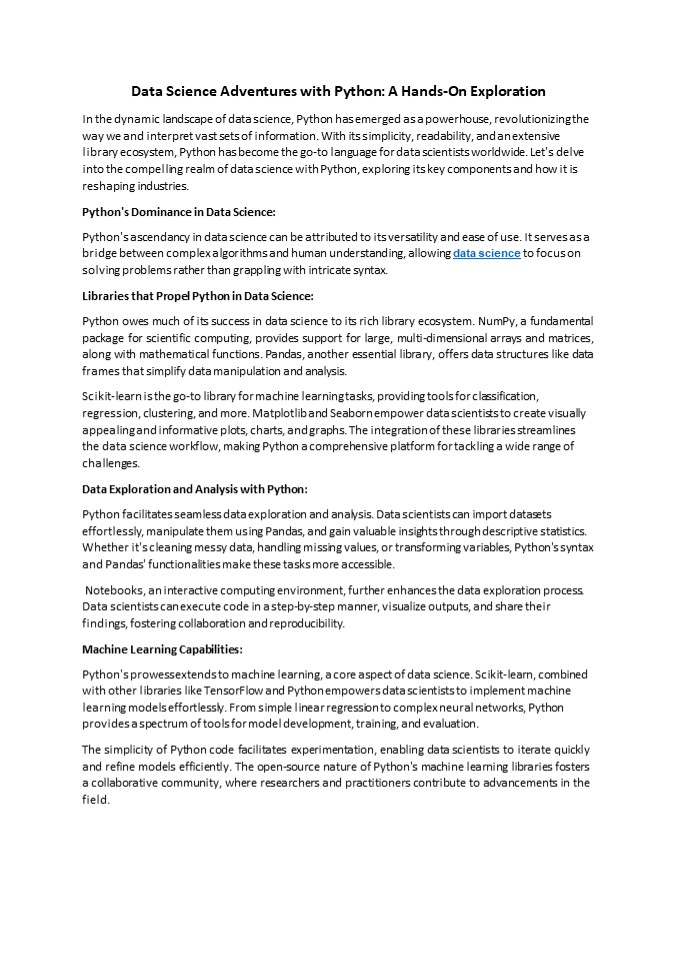Data Science Adventures with Python: A Hands-On Exploration - PowerPoint PPT Presentation
Title:
Data Science Adventures with Python: A Hands-On Exploration
Description:
Python's ascendancy in data science can be attributed to its versatility and ease of use. It serves as a bridge between complex algorithms and human understanding, allowing data science to focus on solving problems rather than grappling with intricate syntax. – PowerPoint PPT presentation
Number of Views:4
Title: Data Science Adventures with Python: A Hands-On Exploration
1
Data Science Adventures with Python A Hands-On
Exploration In the dynamic landscape of data
science, Python has emerged as a powerhouse,
revolutionizing the way we and interpret vast
sets of information. With its simplicity,
readability, and an extensive library ecosystem,
Python has become the go-to language for data
scientists worldwide. Let's delve into the
compelling realm of data science with Python,
exploring its key components and how it is
reshaping industries. Python's Dominance in Data
Science Python's ascendancy in data science can
be attributed to its versatility and ease of use.
It serves as a bridge between complex algorithms
and human understanding, allowing data science to
focus on solving problems rather than grappling
with intricate syntax. Libraries that Propel
Python in Data Science Python owes much of its
success in data science to its rich library
ecosystem. NumPy, a fundamental package for
scientific computing, provides support for large,
multi-dimensional arrays and matrices, along with
mathematical functions. Pandas, another essential
library, offers data structures like data frames
that simplify data manipulation and
analysis. Scikit-learn is the go-to library for
machine learning tasks, providing tools for
classification, regression, clustering, and more.
Matplotlib and Seaborn empower data scientists to
create visually appealing and informative plots,
charts, and graphs. The integration of these
libraries streamlines the data science workflow,
making Python a comprehensive platform for
tackling a wide range of challenges. Data
Exploration and Analysis with Python Python
facilitates seamless data exploration and
analysis. Data scientists can import datasets
effortlessly, manipulate them using Pandas, and
gain valuable insights through descriptive
statistics. Whether it's cleaning messy data,
handling missing values, or transforming
variables, Python's syntax and Pandas'
functionalities make these tasks more
accessible. Notebooks, an interactive computing
environment, further enhances the data
exploration process. Data scientists can execute
code in a step-by-step manner, visualize outputs,
and share their findings, fostering collaboration
and reproducibility. Machine Learning
Capabilities Python's prowess extends to machine
learning, a core aspect of data science.
Scikit-learn, combined with other libraries like
TensorFlow and Python empowers data scientists to
implement machine learning models effortlessly.
From simple linear regression to complex neural
networks, Python provides a spectrum of tools for
model development, training, and evaluation. The
simplicity of Python code facilitates
experimentation, enabling data scientists to
iterate quickly and refine models efficiently.
The open-source nature of Python's machine
learning libraries fosters a collaborative
community, where researchers and practitioners
contribute to advancements in the field.
2
Data Visualization for Clear Communication Effect
ive communication of insights is crucial in data
science. Python's visualization libraries, such
as Matplotlib, Seaborn, and allow data scientists
to create compelling visuals that convey complex
information in a digestible format. Whether it's
interactive dashboards or static plots, Python
enables professionals to tell a story with their
data. Community and Support Python's vibrant and
active community plays a pivotal role in its
dominance in data science. The community-driven
development model ensures constant updates, bug
fixes, and the introduction of new features.
Online forums, tutorials, and documentation make
it easy for beginners to learn Python for data
science and seek guidance from experienced
practitioners. Real-world Applications The
impact of data science with Python extends across
various industries. From finance and healthcare
to marketing and technology, organizations
leverage Python's capabilities to extract
meaningful insights from data. Predictive
analytics, fraud detection, recommendation
systems, and autonomous decision-making processes
are just a few examples of how Python is
transforming industries.
3
Conclusion In conclusion, data science with
Python is a compelling journey that empowers
individuals and organizations to harness the
power of Data Science With Python versatility,
combined with its robust library ecosystem, makes
it an ideal language for data exploration,
analysis, and machine learning. As we navigate
the ever-evolving landscape of technology, Python
stands as a beacon, guiding data scientists
towards innovation and discovery. Whether you're
a seasoned professional or a newcomer to the
field, the allure of data science with Python
lies in its accessibility, scalability, and the
endless possibilities it unlocks in the world of
data.































